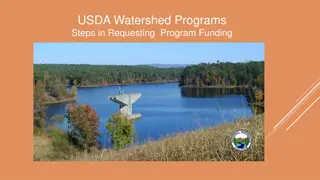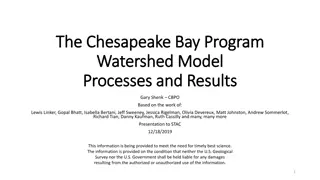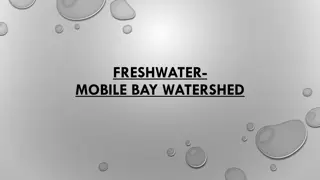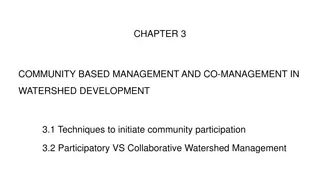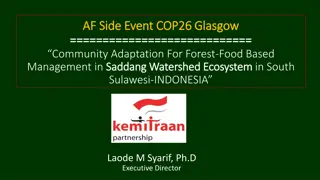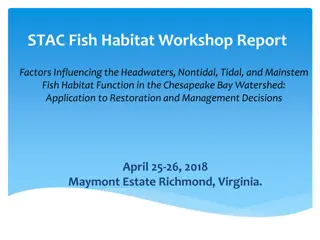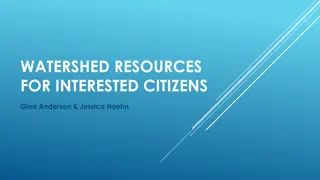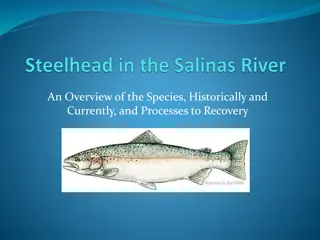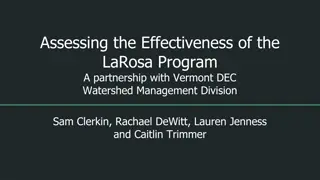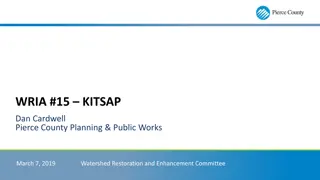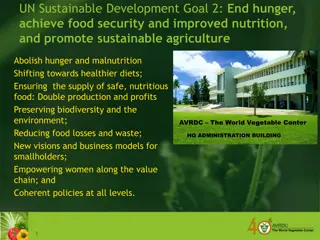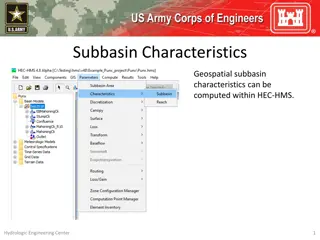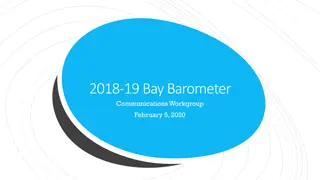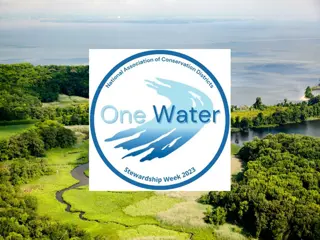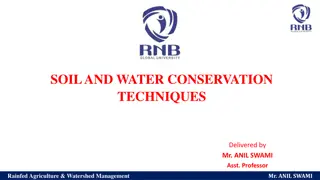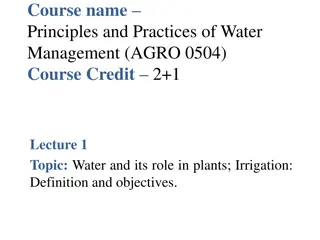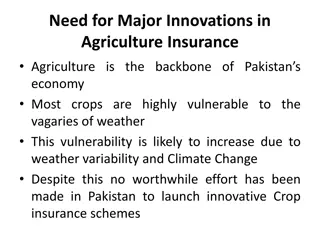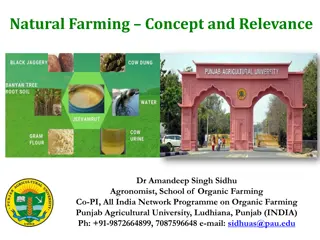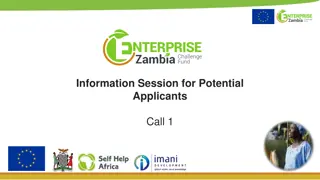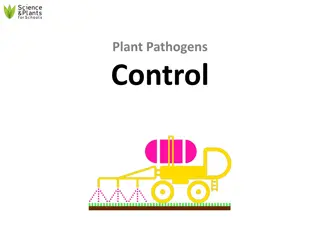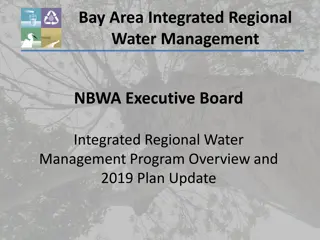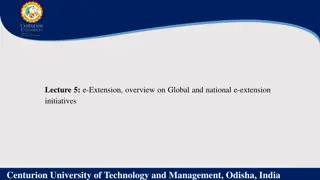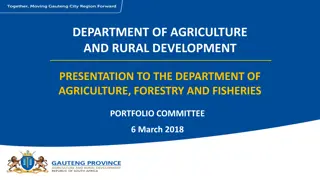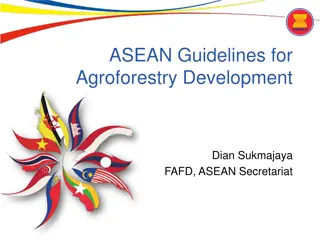Urgency of Watershed Management for Sustainable Agriculture
Watershed management is crucial due to dwindling land availability, water scarcity projections, and the severe threat of soil erosion and land degradation. With vast regions affected by these issues, especially in rainfed areas, there is a pressing need to address resource degradation to ensure food security and environmental sustainability in India.
Uploaded on Sep 12, 2024 | 0 Views
Download Presentation

Please find below an Image/Link to download the presentation.
The content on the website is provided AS IS for your information and personal use only. It may not be sold, licensed, or shared on other websites without obtaining consent from the author. Download presentation by click this link. If you encounter any issues during the download, it is possible that the publisher has removed the file from their server.
E N D
Presentation Transcript
CONCEPT AND RELEVANCE OF WATERSHED MANAGEMENT JAYASREE M TECHNICAL EXPERT (AGRI) SLNA
WHY WATERSHED MANAGEMENT? Per capita availability of land in 1951 is 0.91ha Per capita availability of land in 2050 will be 0.17ha Per capita availability of water in 1951 is 5300cum Per capita availability of water in 2050 will be 1235cum
Rampant soil erosion and degradation of land and water resources are further posing serious threat to food, environmental, social, economic and livelihood securities.
About half of the geographical area of the country is affected by different forms of soil erosion and land degradation . This causes loss of productivity, floods and droughts and also environmental hazards and reduction in livelihood opportunities.
Rainfed areas constitute about two-thirds of nation s cultivated area. This rainfed areas are the resource poor areas with low levels of productivity and suffer from land degradation and other vagaries of nature.
Rainfed areas contribute only 45% of the total food production. Irrigated areas which account for 37% of the cultivated area contribute 55% of total food production.
Resource degradation and loss are the major adverse impacts of Indian agriculture. About 5334 million tons of soil is estimated to be eroded annually. 29% is permanently lost into the sea 10% is deposited in reservoirs 61% is transported from one place to another.
Average annual loss of plant nutrients is 5.3 to 8.4 million tonns. If this continues one third of the arable land is likely to be lost in a period of 20 years.
First Green Revolution focus on increase in production through new inputs especially in irrigated areas. The next revolution has to come by introduction of new innovative techniques and use of efficient location specific natural resources management in farms and fields in rainfed areas.
Agriculture must be considered as the primary industry of any country. Land is the capital of the industry. A good proportion of our agricultural land is put to non agricultural purposes and for cultivation of non food crops.
Water is one of the constituent of the five vital elements of human body. About 30,000 people die every day especially in the poorer parts of the world due to inadequate supply of water or its unsanitary condition. WHO estimates that 80% of all illness are related to water.
The rainfall remains almost the same but the population depend on this rainfall is on the increase. Hence conservation and management of water resources must be considered a vital necessity for the humanity to survive.
STATUS OF KERALA Kerala state is deficit in food production to the tune of 75%, still continue to fill the precious paddy fields for non agricultural purposes and urbanization. Kerala once had more than 10 lakh ha of paddy field, today only 1.5-2lakh ha.
19 lakh ha in Kerala is already under varying degrees of land degradation causing lowering of productivity of crops, drying up of streams, lowering of ground water etc.
KERALA SCENARIO Rivers - 44 Lakes - 34 Rainfall - 3000mm Inspite of all these we are facing food scarcity and price hike.
Production of food grains - <15% of requirement Production of Pulses - <7% of requirement Production of vegetables - <25% of requirement Similar for milk, eggs, fish and fishery products
FOOD DEMAND Vs PRODUCTION(2010-11) IN KERALA Item Demand (Lakh tonnes) Production (Lakh tonnes) %of gap Food Grains 43.50 5.70 86.90 Pulses Vegetables Fruits Milk Fish Meat Eggs 4.89 37.40 36.60 34.25 36.60 1.80 0.31 8.00 14.90 26.43 6.81 1.25 1685.60 93.70 78.60 59.30 22.83 81.39 30.55 72.65 6163.50(Million no)
Our state is witnessing a steady decline in the area and production of food crops over the last few decades. A shift in cultivation from high volume low value crop like rice and tapioca to low volume high value crop like pepper and rubber.
Item Area during seventies 8.75 lakh ha 2011-12 Rice 2.08 lakh ha Food crops(rice, pulses and tapioca) 18.63% (2001- 02) 10.75%
We cannot retain even the remaining area under food production. There was a reduction of 4% in total area under food crops during 2011-12 than 2010-11 For food grains the reduction is 3%
The question is how long can we survive on food outside? We must produce the maximum in our state itself. brought from
CONSTRINTS IN FOOD PRODUCTION Rapid decline of our natural resources viz; land, water and biomass which are necessary for sustained production. Declining trend of resource flow to agricultural sector leading to increased indebtedness of small and marginal farmers. Increase input cost Decline in productivity Technology fatigue Weakened extension services
CHALLENGES OF TODAY To satisfy people s right to food security ie., to feed the escalating population by keeping the prices low for the benefit of poor consumers as well as to reduce production cost to benefit poor growers. To ensure that natural resource base remains sustainably productive.
To ensure food security, increase rice production while keeping the production costs low should be the first step. For increasing production focus should be given to sustainable production systems by strengthening the ecological foundations.
This requires a holistic approach by considering technological, bio-physical, socio-economic, political and environmental factors. Food security and environmental sustainability can be attained by improved land and water management adopting eco-friendly technologies and initiating good agricultural practices.
WATERSHED MANAGEMENT The whole issue of ensuring food security in Kerala has to be viewed in the context of a watershed management Conservation and augmentation of soil and water resources Improving productivity by increasing the fertility Introduction of better yielding crops Crop diversification
Integrated Watershed Management has emerged as a new paradigm for planning, development and management of land, water and biomass resources with a focus on social and institutional aspects .
BIO INDUSTRIAL WATERSHED The Watershed is on community rather than natural resources alone. The strategy is to augment the local agro ecosystem, adding value to the available resources livelihoods through technological interventions. main thrust of Bio-industrial and enhance suitable
OBJCTIVES OF IWMP Harvesting drinking, irrigation etc to create sustainable sources of income for the village community. Employment generation, poverty alleviation, community empowerment and development of human and economic resources of the rural areas. Restoring ecological balance by harnessing, conserving and developing natural resources. every drop of rainwater for
SALIENT FEATURES It is a centrally sponsored scheme with 90% central assistance and 10% state fund. Implemented based on the principles envisaged in the Common Guidelines for Watershed Development Projects . Duration is 5 years. A cluster of micro watersheds is selected for treatment
Criteria for selection of watershed Acuteness of drinking water scarcity Preponderance of ground water resources Extent of over exploitation of ground water resources Contiguity of another watershed already treated Willingness of village community to make voluntary contributions, enforce equitable social regulations for sharing of common property resources Proportion of SC/ST Project area should not have assured irrigation Productivity potential of the land
State Perspective and Strategic Plan-SPSP Prepared for the entire untreated watersheds of Kerala. Weightage is given for each cluster of micro watersheds based on 12 criteria viz; poverty index, % of SC/ST, % of small and marginal farmers, drinking water, degraded land etc. Cluster of watersheds is selected based on weightage and the allocation of area for each year by GoI
APPROVAL OF PROJECTS Preliminary Project Report (PPR) is initially prepared. It is prepared by various agencies like Soil Survey, KSLUB, NGOs etc SLNA will approve the PPR. Present before the Steering committee meeting and got cleared.
PROJECT MANAGEMANT Phase Name Duration I Preparatory 1 year Phase II Watershed 2-3 years Works Phase III Consolidation 1-2 years and withdrawal Phase
PREPARATORY PHASE Institutional arrangements Detailed Project Report Capacity Building Entry point Activities
INSTITUTIONAL ARRANGEMENTS State Level -SLNA District Level - WCDC PIA level - WDT Grama panchayat level - Watershed Committee Community level - SHGs, UGs, NHGs
Preparation of Detailed Project Report 1% of project cost is set apart Block Panchayat having major area in the project is the PIA Empanelled 20 Technical Supporting Agencies Engage any one of the TSO for preparation of DPR Block panchayat, grama panchayat and PIA should be closely associated with DPR preparation cont ..
AS of projects is obtained from Block panchayat TS as prevailed system in the panchayat DPR should be approved by DPC SLNA a technical scrutinizing committee will scrutinize Approval by SLNA Uploading in the website
Participatory approach DPR preparation Net planning Execution Monitoring Post project management
MANAGEMENT ACTIVITIES IN IWMP NRM-Natural Resource Management Prodction System and Microenterprises Livelihood Support System
NRM ACTIVITIES Soil Conservation Activities Water Conservation Activities Moisture Conservation Activities Other Activities
Soil Conservation Activities Earthen bunds Field bunds Rubble pitched contour bunds Vegetative hedges Contour cultivation Contour trenches Staggered trenches
Water Conservation Activities Check dam Farm pond/ Percolation tank Pond renovation Drainage line treatment Roof top rain water harvesting Pallam conservation
Moisture Conservation Activities Husk Burial Mulching Centripetal terracing Inward bench terracing Moisture Conservation pit
Other Activities Conservation of sacred groves Afforestation
PRODUCTION SYSTEM & MICROENTERPRISES VEGETABLE CULTIVATION FALLOW LAND CULTIVATION BETEL VINE, PINEAPPLE, BANANA, TUBER CROPS, MEDICINAL PLANTS, FODDER, GREEN MANURE CROPS ETC. VERMI COMPOSTING SOIL TESTING FRUITS AND VEGETABLE PROCESSING UNIT SMITHY AND CARPENTRY
Apiculture Sericulture Pisiculture Floriculture Olericulture Farm Mechanisation Value added products Adoption of new innovative technologies Adoption of Success stories etc.
Livelihood Support System 1. Cattle rearing 2. Goat rearing 3. Back yard poultry
CONVERGANCE POSSIBILITIES MGNREGS SHM VFPCK Fisheries Dairy Dept Forest Dept Minor irrigation Agriculture Dept Kudumbasree etc.


